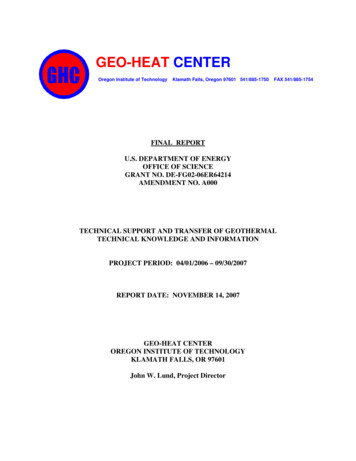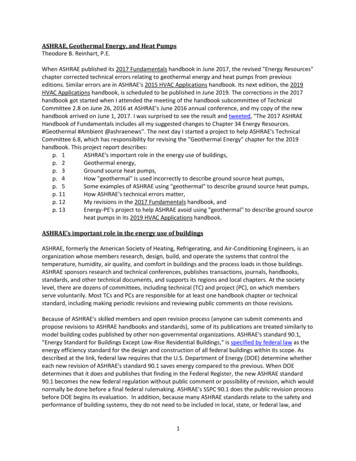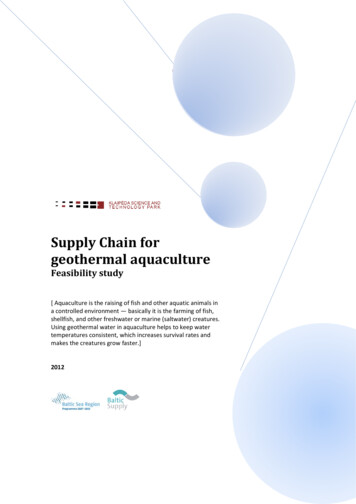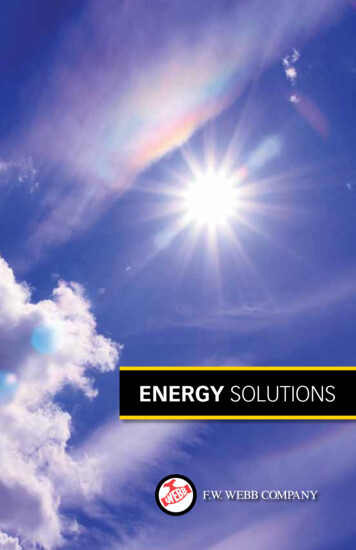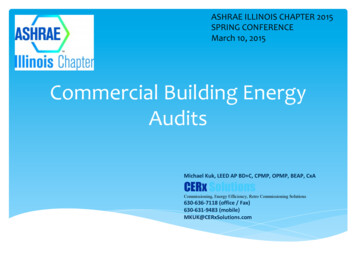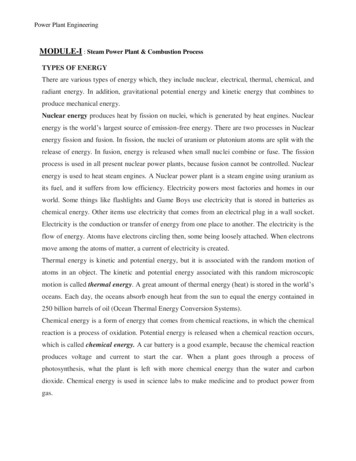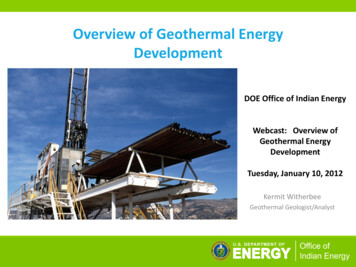
Transcription
Overview of Geothermal EnergyDevelopmentDOE Office of Indian EnergyWebcast: Overview ofGeothermal EnergyDevelopmentTuesday, January 10, 2012Kermit WitherbeeGeothermal Geologist/Analyst
PRESENTATION OUTLINEGeothermal Geology and ResourcesEnvironmental ImpactsGeothermal Technology – Energy ConversionGeothermal Leasing and Development2
GEOTHERMAL GEOLOGYANDRESOURCES3
4Geology – Plate Tectonics
Plate Tectonic Processes Schematic Cross-Section“Magmatic” SystemsCascade Range“Extensional” Systems– “Rifting”Basin and RangeRio Grand RiftImperial ValleyEast Africa Rift Valley
6
7Geothermal Resources(USGS Fact Sheet 2008-3062)StateSystemsIdentifiedMean (MWe)UndiscoveredMean ew MexicoOregonTotal
Geothermal Systems and Public Lands
ENVIRONMENTAL IMPACTS9
10Foot Print and Water ConsumptionLand Use by Energy TechnologyCoalWater Use by Energy TechnologyCoal900Geothermal495Combined cycle47250Natural GasWind3601400NuclearSolarConcentration2600Solar PV430002000Acres/GWh40006000620Geoth-Flash reinj5Geoth-Binary00200 400 600 800Gallons/MWh
Power Plant Comparison - Air EmissionsGeothermal Energy Association11
12Selected Renewable EnergyTechnologiesCapacity FactorsInvestment CostBiomass85Geothermal95Hy dro-Small Scale52Ocean-Wave15Solar -Conc23Solar-PV27Wind-On Shore34Wind-Off Shore43020 40 60 80 100% AvailabilityBiomass Combu Biomass- Geoth-BinaryGeoth-Dual FlashHydro -Small Solar-ConcSolar ParabolicSolar-PVWind 9002,000 1,000/MW4,0006,000
GEOTHERMAL TECHNOLOGY – ENERGYCONVERSION13
World’s 1st Geothermal Power PlantThen: 1904The engine used at Larderello in the firstexperiment in generating electric energyfrom geothermal steam, along with itsinventor, Prince Piero Ginori Conti.And Today:473 MWe
Geothermal Environments Hydrothermal Systems– High Temperature ( 150 C, 302 F) Liquid- and Vapor -Dominated– Moderate Temperature ( 90 to 150 C, 194 F to 302 F) Liquid-Dominated– Low Temperature ( 90 C, 194 F) Liquid-Dominated Hot Dry Rock– Enhanced (Engineered) Geothermal System Cogeneration– Oil and Gas– Geopressure
16Dry Steam Power Plant ( 455o F)Steam is produced directly from thegeothermal reservoir to run the turbines thatpower the generator, and no separation isnecessary because wells only producesteam.GeneratorAir andWater VaporSteamAirThe Geysers Geothermal AreaWorld’s largest dry-steam geothermal field, 22power plants, total capacity of 750 MWeWell Depth: 650-3350 M (2130 – 8200 Ft)Temperature: 240 o- 250o C ( 460 -480 o F)AirWaterProductionWellSteamGeothermal ZoneInjectionWellG A0 2 -5 0 6 8 3 -2 3
17Flash Power Plant (300 F- 700 F)Geothermally heated water under pressure isseparated in a surface vessel (called a steamseparator) into steam and hot water. The steamis delivered to the turbine, and the turbinepowers a generator. The liquid is injected backinto the reservoir. A dual flash cycle separatesthe steam at two different pressures andproduces 20-30% more power than a singleflash cycle at the same fluid flow.GeneratorAir andWater VaporSteamAirWaterBlundell Power Plant Flash plant with binary bottomcycling unitWell Depth: 260 – 2230 M (850 – 7300Ft)Temperature: : 138 o- 267o C (280-512o F)AirWaste BrineProductionWellGeothermal ZoneDirectHeatUsesInjectionWellG A0 2 -5 0 6 8 3 -2 2
18Binary Power Plant (250 F- 360 F)The geothermal water heats another liquid, such asisobutane, which boils at a lower temperature thanwater. The two liquids are kept completely separatethrough the use of a heat exchanger, which transfersthe heat energy from the geothermal water to theworking fluid. The secondary fluid expands intogaseous vapor. The force of the expanding vapor,like steam, turns the turbines that power thegenerators. All of the produced geothermal water isinjected back into the reservoir.GeneratorAir andWater VaporCondenserMammoth-Pacific Power Plants - Twohydrothermal binary power plants generate enoughpower for approximately 40 MWe.Iso-ButaneAirAirHeat ExchangerWaterWell depth: 150-750 M (490 – 2460 Ft)Temperature: 150 o- 175o C (300 -350 o F)WaterCoolBrinePumpProductionWellGeothermal ZoneInjectionWellG A0 2 -5 0 6 8 3 -2 4
19Low TemperatureChena Hot Springs Resort, Alaska: lowest temperature, 165o F, in the world forcommercial power production
20Oil and Gas Well Co-Production and GeopressureChena Power LLC: mobilegeothermal power plant, partlyfunded by DOE to showcaselow-temperature & coproducedresources.Rocky Mountain Oil Field Testing Centeroil and gas coproduction project withOrmat Technologies: 1st successfulgeneration of electricity from binarygeothermal technologies from anexisting oil field.
EngineeredGeothermal Systems(EGS)The Energy Under OurFeetEGS projects produce electricity usingheat extracted with engineered fluidflow paths in hot rocks. Thesepathways are developed by stimulatingthem with cold water injected into awell at high pressure (AltraRockEnergy)21
Current Development Projects22
Total Installed Capacity 2005 - 201023
24Geothermal Powder: Top Countries. InstalledCapacity 4,0002,000-Source: Íslandsbanki Published: 24. 2. 20111990199520002005200720102015
25State# Power PlantsAlaskaInstalledCapacity (MW)Generation(GWh) 1441.81,616New iforniaNevadaTOTALs* EIA, Energy StatisticsChena Hot Springs20 % of Big Island’sdemandOregon Institute ofTechnology –Klamath FallsCampus279DOE-Rocky Mtn OilTest Center15,192
Total Projects in Development Totals by State26
27Growth of Geothermal Projects and Prospects
28Geothermal Leasing and Development
29GeothermalPolicy Drivers, Incentives & ProgramsDOE Geothermal Technologies Program Instrumental in implementation of many of the incentives and subsidies that offset therisk and high upfront capital costProduction Tax Credit Eligible power plants placed in service by 12/31/2013Energy Policy Act of 2005 Geothermal Leasing (PGEIS, Lease Sales) Geothermal Revenue Sharing with Counties Section 1705 – loan guarantees in lieu of PTC ( 175.6M)American Recovery and Reinvestment Act (AARA) DOE Cost-Share Geothermal Investment (total 666.4 M)Renewable Energy Portfolio Standards
30Geothermal Development Process Lease acquisition– Leasing: 25 CFR 211 - LEASING OF TRIBAL LANDS FORMINERAL DEVELOPMENT– IMDA: 25 CFR 225 — OIL AND GAS, GEOTHERMAL, ANDSOLID MINERALS AGREEMENTS Exploration activities Drilling production & injection wells Utilization– Power plants– Direct use facilities Abandonment of wells & facilities Reclamation of surface
31Agency ResponsibilitiesBIABLMGeothermal Leasing(25 CFR 211 - LEASING OFTRIBAL LANDS FOR MINERALDEVELOPMENT)Advisory approvalResource evaluation, mineralsappraisalIndian Minerals DevelopmentAct(25 CFR 225 — OIL AND GAS,GEOTHERMAL, AND SOLIDMINERALS AGREEMENTS)Advisory, ApprovalResource evaluation, mineralsappraisalExploration OperationsGeophysical exploration,including TGWsGeothermal Drilling OperationsGeothermal drilling permitapprovalsUtilization of GeothermalResourcesPlant construction, transmissionGeothermal Resources UnitAgreementsApprovalAccounting and AuditingVerification of production* - Office of Natural Resources Revenue (formally MMS)ONRR*Auditing, collection of revenues,disbursement to tribe/allotmentowner
32IMDA ProcessSource: California Geothermal Energy Collaborative, 2006California Tribal Workshop
Geothermal Permitting - ExplorationOverview of Exploration PermittingDefinition(43 CFR 3200.1)Any activity that: requires physical presence on the land may cause damage to those landExploration Permitting RequirementsAll Activities Evidence of Bond CoverageNotice of Intent (Form 3200-9Estimate of surface disturbanceMeasure to protect the environmentReclamation methodsOther information that may be requiredFor Temperature Gradient Well (TGW) 12 items required (43 CFR 2151.11c)Other than TWG accurate descriptionstarting and ending datesExploration ActivitiesExploration Includes: Construction of Roads & Trails Cross-Country Transit Geophysical Operations Gravity Magnetics Seismic exploration Geochemical Sampling Drilling Temperature Gradient Holes Drilling of Shot-holes Core-DrillingExploration does not include: Direct testing of geothermal resource Drilling of production or injectionwells33
34Exploration OperationsExploration Bonding Necessary prior to surface disturbance Amounts (minimum):– 5,000 single operation– 25,000 for all operations in a single state– 50,000 for all operations nationwide Released:– After request (not automatic)– All wells P&A’d– Surface reclaimed
Geothermal Permitting - Drilling Geothermal Drilling PermitThe Geothermal Drilling Permit describes theoperational aspects of well drilling, including: Description of equipment, materials & procedures Proposed depth Directional specifics, including plan & vertical section Casing & Cementing program Circulation media (drilling fluids) Log description Blow Out Prevention Equipment (BOP) Fresh Water Zones Anticipated Reservoir Temperature & Pressure Anticipated Temperature Gradient Survey Plat by Licensed Surveyor Procedures and durations of well testing Well stimulation –hydro-fracturingGeneral Rules Do not start work until approved Operator must notify local BLM prior toinitiating work File NOI on Sundry Notice If not previously submitted, includeall well completion data Address all 6 items required (43 CFR3263.11) BLM may grant oral approval - butoperator must submit required infowithin 48 hrs. Restore the surfaceBLM may require abandonment If well is no longer needed If well is not mechanically sound Any other information the BLM requires35
36GDPs – BondingDrilling Operations Bonding Necessary prior to surface disturbance– No Cash Bonds– Only LOC or Surety Amounts (minimums)– 10,000 for individual lease– 50,000 for statewide– 150,000 for nationwide Released:– After request (not automatic)– All wells P&A’d– Surface reclaimed
37GDPs – MiscellaneousMiscellaneous The drilling permit, drilling program and operations program can besubmitted together If Operations Plan submitted separately– Submit prior to drilling permit & program– Sundry notice for well pad construction Operations plan and drilling program can cover several wells, buteach drilling permit is well specific Subsequent changes to drilling plan via sundry notice– Oral approval option
38
Well Testing39
40Exploration OperationsAbandonment When no longer necessaryWhen BLM requires itFile NOI on Sundry NoticeDo not start work until approvedReports Your lease, submit all data Unleased acreage or other parties lease, not required to submit unless forDiligent Exploration Expenditure (DEE) Signed NOC 30 days after operations conductedConfidential Information Held confidential per FOIA provisions (all Indian mineral data isconfidential) Details at 43 CFR Part 2
41GDPs – AbandonmentPlugging and Abandonment Do not start work until approved Operator must notify local BLM prior to initiating work File NOI on Sundry Notice– If not previously submitted, include all well completion data– Address all 6 items required (43 CFR 3263.11) BLM may grant oral approval But operator must submit required info within 48 hrs. Restore the surface BLM may require abandonment– No longer needed– Not mechanically sound
42GDPs – ReportsReports (43 CFR 3264) Newly completed wells Subsequent Workovers– Completion Report (Form 3260-4)– 30 days after completion– 4 specific data items––––Subsequent Report30 Days following activity5 specific data itemsBLM may waive this for routine operationsConfidential Information (43 CFR 3266) Held confidential per FOIA provisionsDetails at 43 CFR Part 2Items not held confidential:– Surface location– Surface elevation– Well status
Geothermal Permitting - UtilizationTypes of Geothermal UtilizationDirect Applicant filed Can be issued non-competitively if no interest after 90 days State, Tribal, or Local Governments use resource without sale andfor public purposes other than commercial generation of electricityIndirect Heat energy is used indirectly, most common is ElectricalGeneration EPAct requires nominated tracts to first go through competitiveprocess After sale goes over the counter (retains configuration for 30 days)Provision for Mining Claims Provision in EPAct Allows mining claimants to obtain a non-competitive geothermallease to avoid “top-filing” and utilize the resource Approved mining plan of operations43
DEVELOPERS’PermittingChecklistDATA COLLECTED FOR: 12 steps (see next slide) 8 states (AK, CA, HI, ID, NV, NM, UT, WY)http://www.nrel.gov/geothermal/developer checklistLEVELS OF DATA: 2 main levels: federal, state Sublevels: Land Ownership- federal (BLM, NFS)- private (if applicable and available)AUDIENCE: Project developers scoping out potential projects Project developers developing at a selected locationDevelopers’ Online(known state, land owner) Investors looking at permitting process of potentialinvestment State/local agencies looking to develop and/orimprove permitting process – can comparepermitting process/regulations in other statesPermitting ChecklistNOTE: The checklist is a starting point—developers shouldwork with local stakeholders, supportingorganizations, local agencies, and professionalexperts to maximize their project's success.44
Geothermal Financing OverviewOffice of Indian Energy Webcast: Overview of Geothermal Energy DevelopmentJanuary 10, 2012Paul SchwabeNational Renewable Energy Laboratory
2Agenda1.2.3.4.5.U.S. Geothermal Market SnapshotFederal Incentives for Geothermal EnergyGeothermal Project Development and FinanceChallenges to Financing GeothermalKey Takeaways and Resources
3Geothermal Energy in U.S.3,0002,5002,0001,5001,0005000U.S. Capacity in Drilling orConstruction Phase4002,566MegawattsMegawattsU.S. Cumulative InstalledCapacity in 20114424235162358 3563002001002315138NV CA OR NMIDHI0Source: “Annual U.S. Geothermal Power Production and Development Report,” Geothermal Energy Association.Industry Development in 2010-2011: One 15MW project came online in U.S. in 2010 One 8.6 MW project reached “Mechanical Completion” in U.S. in 2011
4Lingering Difficulties of the 2008-2009 FinancialCrisis on Geothermal DevelopmentLower Risk Tolerances and Shortages of Investment Capital During the economic downturn, some investors left the market, and those thatremained adjusted their tolerance for risk Bloomberg New Energy Finance expects that 2011 was “bottom of the trough”for geothermal market development (Geothermal Market Outlook Q2 2011)
5Agenda1.2.3.4.5.U.S. Geothermal Market SnapshotFederal Incentives for Geothermal EnergyGeothermal Project Development and FinanceChallenges to Financing GeothermalKey Takeaways and Resources
6Policies Impacting Geothermal ProfitabilityGHGRegulationsProjectEconomicsFocus of thispresentationLeasingPoliciesCovered byKermit
7Federal Financial Incentives for duction TaxCredit (PTC)2.2 cents / kWhyearsFirst 10 yearsYesInvestment TaxCredit (ITC)30% of eligibletax basisAt end of 1sttax yearYesIn service by 12/31/13Accelerateddepreciation 56 yearsAt end of first6 tax yearsYesNoneFinancial IncentiveChoose onlyoneModified Accelerated CostRecovery SystemRelevant DatesIn service by 12/31/13Note: Non-exhaustive. For example a diminished 10% ITC is available for projects in service by 12/31/16. Timing and value of federal incentives may change withfuture federal legislation.If utilized, these incentives can recover around half ofgeothermal project’s total installed cost * See: et
8Agenda1.2.3.4.5.U.S. Geothermal Market SnapshotFederal Incentives for Geothermal EnergyGeothermal Project Development and FinanceChallenges to Financing GeothermalKey Takeaways and Resources
9Geothermal Financing InformationGuidebook to Geothermal Power Finance– Geothermal Electric Power– Conventional Technologies– Utility Side of Meter (i.e. several MWs)Distilled Information available at:http://www.nrel.gov/geothermal/financing/
10Stages of Geothermal DevelopmentDevelopment Time 4 to 7 ationTest WellDrillingProductionWell DrillingPlantConstructionExplorationPermitting ngPlant &ConstructionTransmission 1% 10% 5% 35-40% 50%of costsof costsof costsof costsof costsSource: Adapted from “2008 Geothermal Technologies Market Report,” U.S. DOE, July 008 market report.pdf
11Staging of Geothermal Financing & DevelopmentModerate RiskResourceIdentificationHigh RiskResource EvaluationEarly-Stage FinancingTest Well DrillingProduction WellDrillingLate DevelopmentLow RiskPlant ConstructionPlant OperationConstruction and Project FinanceMultiple investors with diverse risk profiles are typicallyneeded to raise the capital needed for geothermal powerprojects
12Sources of Funds for Geothermal FinancingEarly-Stage EquityProject RiskExchange Traded EquityPrivate EquityCorporate Balance SheetMezzanine FinanceBank LoanCorporate DebtCorporate Lines of CreditConstruction and Project Operating FinanceBank Loans Often Bundle These Two Products
13Staging of Geothermal Financing & DevelopmentModerate RiskResourceIdentificationHigh RiskResource EvaluationTest Well DrillingEarly-Stage FinancingLow RiskProduction WellDrillingPlant ConstructionLate DevelopmentPlant OperationConstruction and Project FinanceNon-Financial Requirements / Milestones» Experienced and qualified management team» Risk mitigation strategies in place» PPA with creditworthy counterparty» Resourceassessmentfrom a wellrespected firm» Drillingcontract inplace» Engineers’ report affirmingresource availability for 20years» At least 50-80%of productionwells drilled» Engineering,procurement,construction(EPC) contract
14Examples of Recent Financing StrategiesFinancing TypeFinancingCostExampleExchange Traded Equity / HighPublic Issuance Ram Power ENEL Power Ormat Calpine CorporationPrivate EquityHigh Gradient Resources / Vulcan Power Terra-Gen PowerMezzanine FinanceModerateto High Glitnir Bank / IslandsbankiBalance SheetModerate Ormat Chevron CorporationConstruction /Permanent FinancingModerateto Low Common industry practice
15Agenda1.2.3.4.5.U.S. Geothermal Market SnapshotFederal Incentives for Geothermal EnergyGeothermal Project Development and FinanceChallenges to Financing GeothermalKey Takeaways and Resources
16Challenges to Financing Geothermal: Failing toPlan for RiskRisk Not Adequately Accounted For Failure to plan for the unexpected Inadequate contingency funds “The process takes longer and costs more than anticipated” – DanielFleischman, OrmatSeeking Funding from Improper SourceSeeking Financing before Meeting Milestones
17Challenges to Financing Geothermal: SeekingFunding from Improper SourceRisk Not Adequately Accounted ForSeeking Funding from Improper Source Must match investor risk appetite with appropriate project stage At best, results in extended project timeline At worst, inability to secure financingSeeking Financing before Meeting Milestones
18Challenges to Financing Geothermal: SeekingFunding before Meeting MilestonesRisk Not Adequately Accounted ForSeeking Funding from Improper SourceSeeking Financing before Meeting Milestones Must meet milestones/metrics set by investors at each stage Similar consequences as seeking funding from improper source
19Agenda1.2.3.4.5.U.S. Geothermal Market SnapshotFederal Incentives for Geothermal EnergyGeothermal Project Development and FinanceChallenges to Financing GeothermalKey Takeaways and Resources
20Key Takeaways No magic bullet for financing geothermal power projectsInnovative approaches to investment in geothermal power projects leveragestate and federal policies and target specific investor profilesStaging investment enables project developers to match the project’s riskprofile at a given stage with investors’ risk toleranceDevelopers can address key challenges to financing geothermal powerprojects by being aware of investors’ requirements and needsAdditional Information: DOE’s Tribal Energy Program:http://apps1.eere.energy.gov/tribalenergy/ DOE’s Geothermal Technologies Program:http://www1.eere.energy.gov/geothermal/ NREL’s Financing Geothermal Power Projects:http://www.nrel.gov/geothermal/financing/
21Thank You!Paul SchwabeRenewable Energy Financing AnalystNational Renewable Energy Laboratory(303)-384-7468paul.schwabe@nrel.gov
22Guide to Geothermal Power Finance Online Resourcewww.nrel.gov/geothermal/financing
23Geothermal Investment by UtilitiesRegulatorshesitate tocommit ratepayerfunds to riskydevelopment(20% to 50% dryholes).Competition for ProjectsSimilarly,regulators are notfamiliar withtechnology.Utilities’approved rates ofreturn are notsufficient toaccommodatethe early-stagerisk.Regulator ConcernUtilities areunfamiliar withthe technology.Insufficient ReturnsUnfamiliarity Utilities have not been fully active in geothermal project investment forreasons listed below, however One important role that utilities do play is to sign contracts forgeothermal power and RECs that are fundamental to financing projectsBy the timeutilities’ rates ofreturn aresufficient towarrantinvestment (i.e.,Construction),other entitiesoffer financing atattractive rates.
Oil and Gas Well Co-Production and Geopressure Chena Power LLC: mobile geothermal power plant, partly funded by DOE to showcase low-temperature & coproduced resources. Rocky Mountain Oil Field Testing Center oil and gas coproduction project with Ormat Technolog
